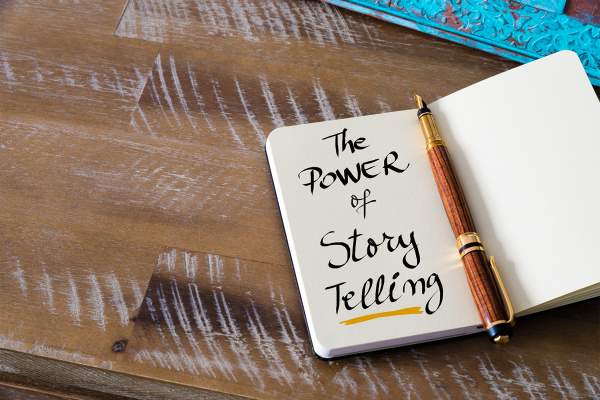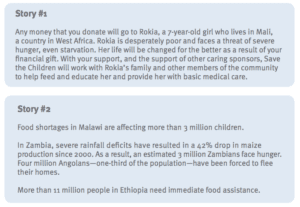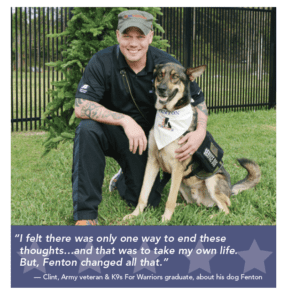Nonprofit Storytelling: Three Mistakes You Might be Making

A few months ago, several of our team members had the chance to fly up to Syracuse to visit with one of our clients, the Rescue Mission Alliance. They were lucky enough to stick around for RMA’s Hope Awards, a celebration of the changed lives and personal achievements of many of RMA’s past and present beneficiaries. There were tears, laughter, and inspiration. The Nexies came back glowing, full of stories that had touched their hearts — stories that, they felt, would touch the lives of donors.
It served as a good reminder that, even though we can get excited about new technologies and their implications for the future of fundraising, the stories are what donors keep coming back to.
It’s fun to experiment with the vehicle of the story: virtual and augmented reality, slickly produced video, attention-grabbing pop-up ads. But above all we are storytellers, and we are honored to tell our clients’ stories — stories that we hope people will identify with and respond to.
If you feel like your nonprofit is telling the same, stale story over and over or you’re not seeing the results you want, perhaps you’re making one of these three very common storytelling mistakes.
Mistake #1: Trying to appeal to the rational instead of the emotional. Yes, humans are rational beings. But it turns out that when it comes to giving, we give with our hearts, not with our heads. Of the stories below, which one would inspire you to give?

via Network for Good
If you chose Story #1, you are with the majority of givers in responding more positively to vivid stories rather than to statistics or figures. One would think that shocking numbers or facts would inspire people to take action, but Professor Deborah Small of Wharton University conducted a study in which she found that the opposite is actually true. “Statistics,” she said, “can actually blunt this emotional response by causing people to think in a more calculative, albeit uncaring, manner.”
In other words, when we start thinking rationally, we often feel the helplessness of the situation and lose our motivation to give.
Good stories, on the other hand, appeal to certain emotions: joy, anger, fear, sympathy. They make your prospects feel so happy, angry, scared or sympathetic that they simply MUST do something — hopefully respond to your call to action. So don’t be afraid to play to these emotions!
Every day on the news we see images and stories from war-torn countries like Iraq, Syria, or Yemen. We hear so many heartbreaking statistics that we’ve almost become desensitized to them. That’s why, when we tackled UNICEF Ireland’s February appeal to raise money for their work in Iraqi refugee camps, we knew we had to tell a story.

The package focused on one child: 13-year-old Nisreen, an Iraqi girl forced to flee from her home due to the fighting. It included quotes from Nisreen and her family, as well as color photographs depicting what their life is like. Though we did include statistics and figures about what the war has done, the real focus was Nisreen — and as donations come in, we know that people are giving because they feel compassion for Nisreen and children like her, not because of shocking facts they could hear on the news. Though facts, statistics, and numbers are valuable and should be provided to donors who are interested (perhaps on your website), they should never take center stage over the stories of people.
Mistake #2: Not having a relatable protagonist in your story. Every cause needs a “poster child.” And though your organization may be working with an entire population or demographic, focusing on one face and one story is proven to increase engagement — and donations.
It’s important to put a face to your cause — through both vivid narrative and imagery. Professor Small calls this the “identifiable victim effect” — people are more likely to respond when they focus on one victim and one story rather than a large group of victims. So even if you have many great stories to tell, really dive in to just one. Quality is more important here than quantity.
Think of the stories that have made you feel something lately: A photo of two-year-old Alan Kurdi washed up on the shore of Turkey captured the entire country’s attention and alerted them to the refugee crises in Europe when pictures of displaced hordes and daily news reports could not. Young Omran Daqneesh, a victim of the Syrian war, sitting dazed and bloodied in an ambulance outside of Aleppo, evoked our emotions even when we rationally knew that unspeakable tragedies were already happening there every day.
When people are forced to imagine themselves, their child, grandchild, or sibling in the same position, the story becomes more real. In the same way, nonprofit storytelling, even when tragic, should be relatable.
In our latest K9s For Warriors direct mail campaign, we used the story of Clint — a veteran with PTSD who considered ending his life until he went through the K9s For Warriors program and got his service dog Fenton. Donors can relate to Clint because he reminds them of someone they might know: a father who just wants to spend more time with his family and friends.

Clint’s image was used on the outer envelope, and his story was woven throughout the letter and expanded upon in an insert. The call to action was even part of the story: we invited donors to “Save more lives like Clint’s and Fenton’s” rather than asking them to simply “Donate now.” Finally, Clint’s image was included in the email to provide consistency throughout the multi-channel campaign. His story resonated with donors, and this campaign surpassed all our projections.
If your donors can’t imagine themselves in your protagonist’s shoes in SOME way, they will put the letter down, skip the ad, delete the email, or hang up the phone.
Mistake #3: Making your organization the hero of the story. It’s great to be proud of your organization. But often nonprofits rely too strongly on what author and communications consultant Andy Goodman calls the “we came, we saw, we conquered” approach — framing the organization as the hero of the story.
Crystaline Randazzo of NGO Storytelling says it this way: “If you’re like me, you’ll find that it’s easy to fall back on the beneficiary story. Person A has a problem and Nonprofit B provides them with something that improves their lives. There is nothing inherently wrong with this very linear story, but we’ve all seen it before — and it loses impact over time.” Whether it’s a dog in a shelter, a homeless man, or a woman in rehab, we’ve all heard that story so many times that it loses its effectiveness.
It might be time to change your angle a bit. Consider framing your beneficiaries, your volunteers, or (even better) your donor as the hero of the story.
Our May campaign for Operation Blessing told the story of Garmai, a mother, nurse, and first-responder to the Ebola crisis in West Africa. In the first half of the letter, Garmai is framed as the hero of the story: taking part in a massive relief effort and caring for orphaned children.

But the “twist” comes at the end of the letter. The hero isn’t just Garmai and those responding to the crisis, but those who are reading the letter who have donated to help bring about a happy ending. It reads:

But remember, the story does not always have to end happily. Leaving the story unfinished is a great tactic to use in nonprofit storytelling because it invites the viewer to step in and help shape the future of the story by donating, acting, or caring. Giving your donors a chance to be a hero gives them what fundraising expert Alan Clayton calls “emotional glow” — a feeling that will keep them donating to and engaged with your organization over and over again.
Whether you are telling a story through direct mail, video, social media, or print, make 2017 the year you stop telling the same story. Instead, find an angle that your donors and prospects can empathize with. Then, invite them to step into that story and write the ending for you.
